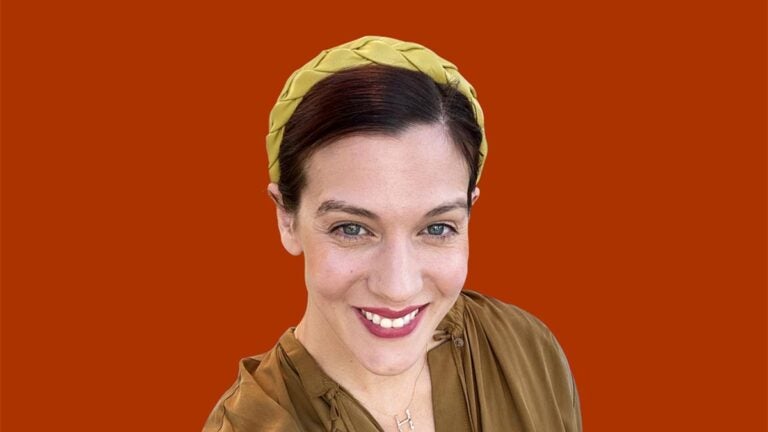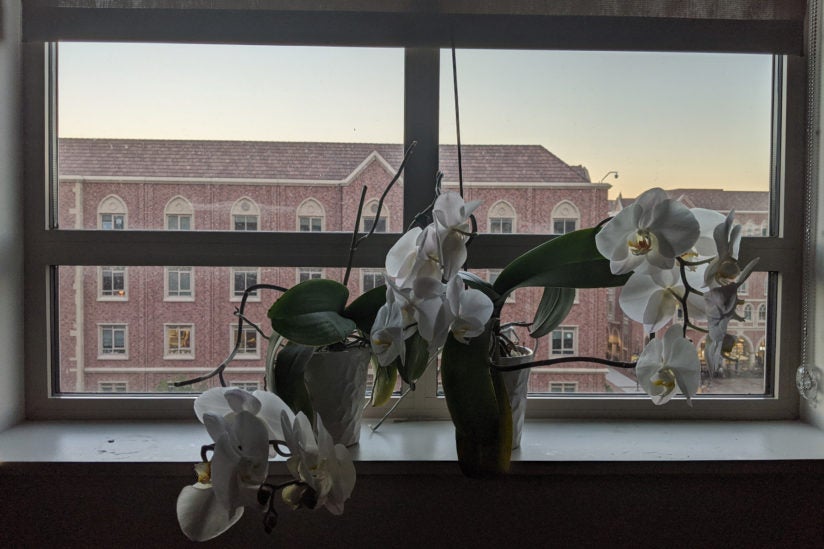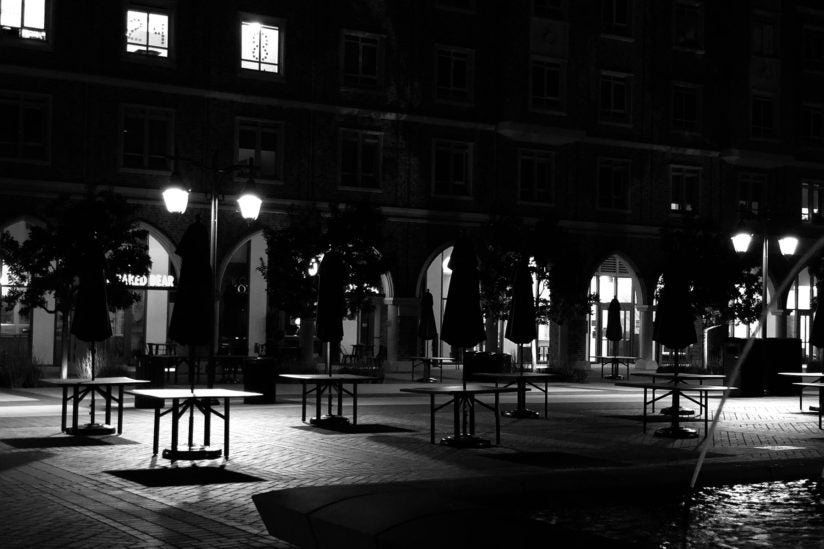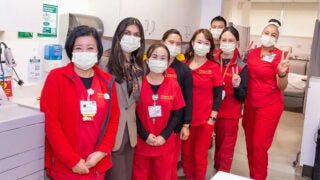
With neon parties and nonstop chatter, it’s springtime in the fall at USC Village
The faculty-in-residence at USC Village got a lesson in leaving when students headed home during the pandemic lockdown. Now, those faculty find themselves in the middle of a noisy renaissance.
In a window frame high above USC Village’s central piazza, a couple of orchids seek the sun outside McMorrow Residential College. They’re survivors, having made it through the pandemic lockdown that forced most of the students who live at the village’s eight residential colleges to head home in mid-March of last year.
As students rushed to leave, Neelesh Tiruviluamala, one of six faculty-in-residence at USC Village residential colleges, bumped into mechanical engineering student Kenya Foster. She was on her way home to Kansas City, Missouri, and didn’t have a lot of time.
“She said, ‘Please take care of my big plant babies’,” Tiruviluamala remembers. “I’m not sure why she thought I could do it, but those plants are flourishing.”
USC Village’s residential colleges, shops, stores, restaurants and gathering places are flourishing as well. It’s a gratifying moment for the six faculty members-in-residence who both live and work at the village’s six residential colleges. Like their 14 colleagues across campus, this cohesive group — residents of the Village since it opened in 2017 — are feeling buoyed by the bustle. It’s October, but it feels like spring after a long winter.
USC Village empties out as COVID spreads
USC Village opened more than four years ago. Its residential faculty grew into a neighborly group that includes Tiruviluamala, Laura Baker, Ruth Chung, Trisha Tucker, Broderick Leaks and John Pascarella.
Three are parents who have or had kids living with them at the village. That will soon become four. John Pascarella and his wife Erin, who married at an outdoor ceremony in April, will join the USC Village faculty parents’ club early next year — almost two full years after he watched most of the village’s 2,500 students pack up as the pandemic darkened.

“It was difficult emotionally, for everyone, because of the relationships we built,” Pascarella said. “That was also early on — the days of confusion and panic-buying.”
Baker remembers the thoughtfulness and generosity of students — especially after they’d gone home.
“They’d ordered things like hand sanitizer and toilet paper, which was going to arrive at the Amazon hub downstairs, so they sent me the links and I picked those up. They were in short supply at the time. It’s a little thing, but it was so thoughtful. Then it became a ghost town.”
Empty chairs and empty hallways define the village during lockdown
Some of those ghostly feelings are captured in photographs showing artifacts of a semester cut short: empty chairs, deserted plazas and bulletin boards with flyers announcing scheduled events that would never happen.
“Those bulletin boards stayed well into the early part of this year,” Chung said. “It was a bit like Pompeii — everything frozen in time.”
Wide hallways in Bohnett and Nemirovsky residential colleges became runways where Leaks’ adolescent son Maxwell and toddler daughter Alanis could safely cavort, a memory both magical and eerie.
“It was maybe like The Shining, I guess,” Leaks remembered, “but mostly it was really cool because the whole building became their playland.”
The group gathered — observing safety protocols — throughout lockdown. The get-togethers, however brief and informal, broke monotony for those living in what temporarily became a nearly vacant housing complex.

(Photo/Courtesy of Erin Lanahan and John Pascarella)
“At night, there were hardly any lights in the windows, so just knowing there were folks here was important,” Chung remembers.
Resident Residential Education professional staff, who served multiple roles including peer mentoring during lockdown, were invaluable — especially for students slogging through isolation. They worked around the clock, including weekends and holidays, responding to calls that included crises and mental health concerns.
“It was clear to me that they had been trained in social and emotional health literacy and well-being,” Pascarella said. “They were really focused on making sure the students had support and someone to connect with, even if it was virtual.”
“They were resourceful and resilient; they kept their sense of humor,” Baker said.
Emptiness is a memory as USC Village reopens
The shops at USC Village have plenty of customers now. The residential colleges are occupied, the windows no longer dark in the evenings. Masks, Trojan Checks and unpopular lines linger — not unlike post-lockdown inconveniences found elsewhere. The faculty living above don’t seem to mind, even if they worry just a little about the kids — including their own.
“My son Joshua is among the students who didn’t get to enjoy a traditional freshman year here, and now he’s down there in the midst of it — all this amazing energy,” Chung said. “As a parent, I’m glad. At the same time, this is a huge social experiment, so I have mixed feelings.”
“It’s the coolest thing to see so much so many people and so much energy,” said Leaks, who also serves as director of student counseling and mental health. “On the flip side, I tell people I literally have this tension. It’s like COVID, COVID, COVID.”
Those tensions appear to be easing as positivity rates among students continue to decline.
“We have a great view of the lawn, and we got to watch the welcome events,” said Tucker. “It was like a neon party in the backyard.”
The party continues in hallways, walkways and the classes Baker teaches.
“It’s hard to get them to be quiet,” she said. “At every class, every meeting, I’m trying to give them an opportunity to talk to each other, to connect with each other, because that’s what they want to do.”



